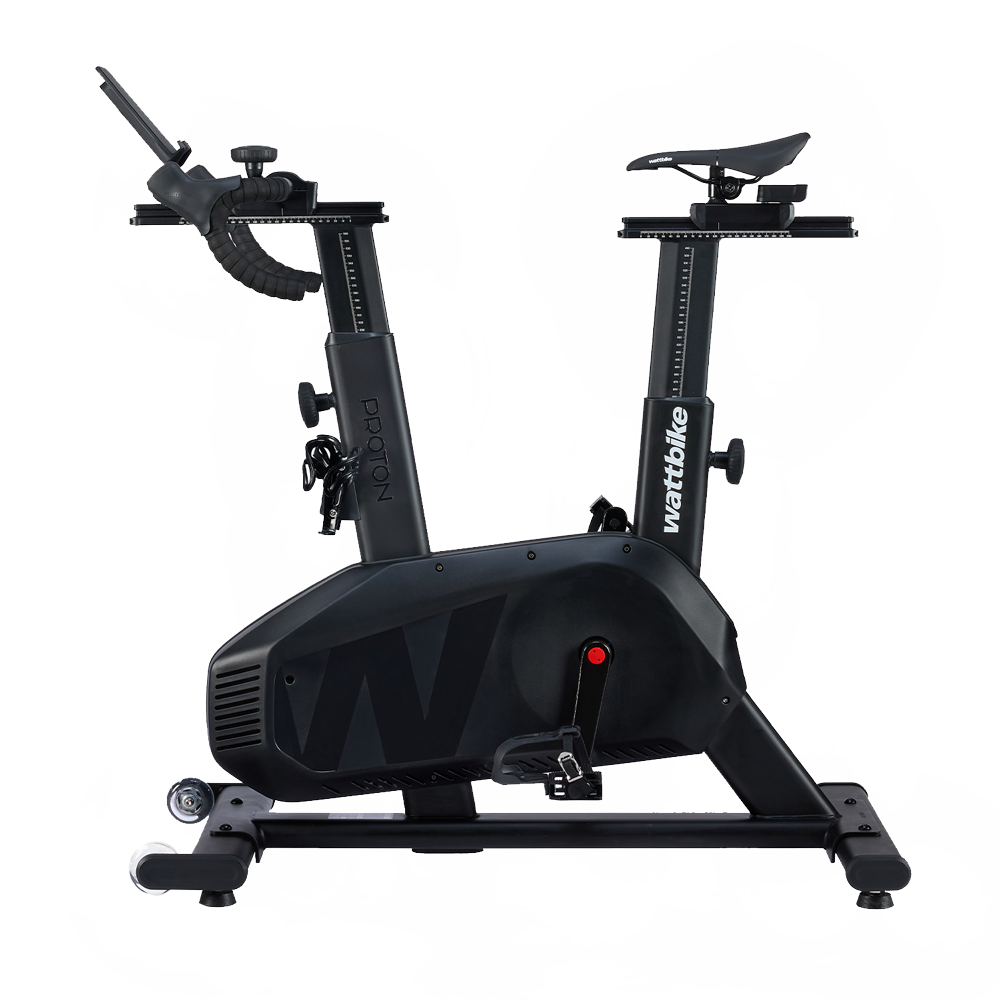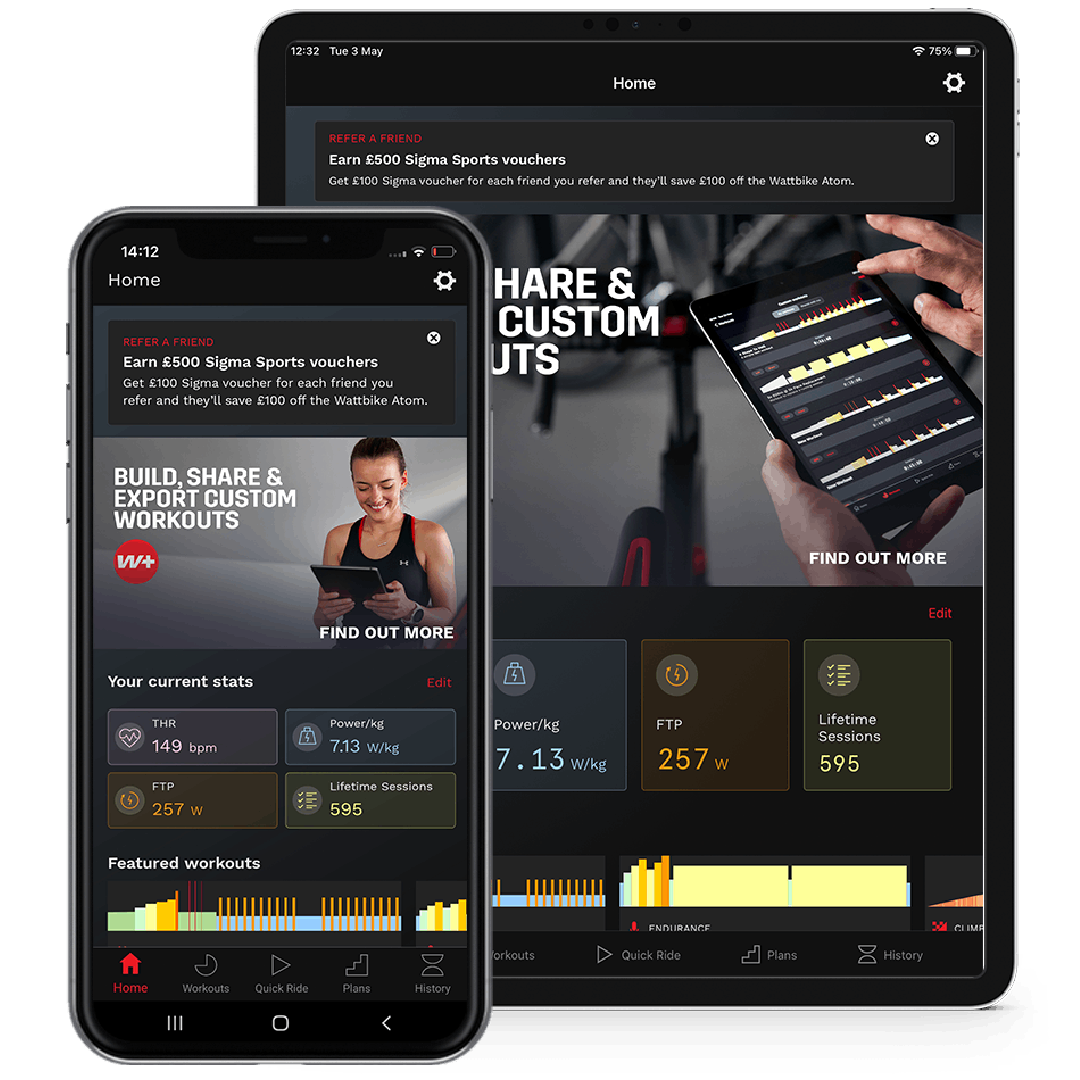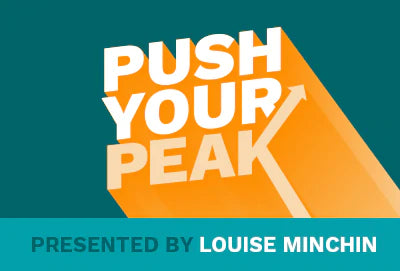Your Cart is Empty
shop
training & apps
support & services
news & information
Maximise Your Running Performance with Wattbike Proton
October 17, 2024 3 min read
The Bike Setup Guide for Runners
Training for running doesn’t have to be limited to hitting the pavement or treadmill. Incorporating cycling on a Wattbike can enhance your overall fitness, build endurance and improve your running form, while taking the load off your feet.
But how do you ensure your Wattbike is set up to complement your running training? Here’s a comprehensive guide to help runners optimise their Wattbike setup for a powerful and effective workout.

Transitioning from In to Out of the Saddle
If you’re new to cycling, moving from seated pedalling to standing pedalling can feel awkward. Much like any new movement, it takes time to master. You might feel disconnected or uncoordinated at first, but with persistence, this movement will become smoother and more natural.
To improve your transition, pay close attention to the resistance and cadence. Finding the right combination of these two elements is key for a fluid motion. Experiment with different settings until you find a comfortable rhythm that works for your body.
Managing Intensity
Cycling out of the saddle is a high-intensity activity. When you're out of the saddle, you’re often pushing close to your full functional threshold power (FTP), which means intervals in this position are typically shorter. Keep this in mind when structuring your workouts, particularly for running-focused training. The bulk of your workout's intensity will be managed while seated, with lower intensity and longer intervals.
The Ideal Wattbike Setup for Running Training
To maximise your performance and ensure your body mimics a running posture while cycling, you’ll need to adjust your bike’s settings. Here’s how:
1. Saddle Height
For optimal running posture, set your saddle on the higher side of the typical cycling range. Aim for a slight downward point of the toes - just past horizontal and ensure your knee almost straightens but never locks out. A knee angle between 145˚ and 150˚ is recommended. Your pelvis should barely shift side to side; if it’s rocking noticeably, lower the saddle slightly.
2. Saddle Fore-Aft Position
For most runners, moving the saddle forward aligns the body more closely with a running stance. Try to keep the saddle nose vertically in line with the bottom bracket. Taller riders may find it beneficial to move the saddle slightly back, while shorter users may want to move it forward. Adjust the fore-aft position until you find a balance that feels natural both in and out of the saddle.
3. Handlebar Height
To mimic a running posture, the handlebars should be set higher than the saddle. The higher the handlebars, the more upright you’ll be, which shifts your body weight onto your feet during out-of-saddle pedalling. A lower handlebar position will distribute some weight to your arms, so find a height that feels sustainable for longer workouts.
4. Handlebar Fore-Aft Position
The handlebar’s distance from the saddle will vary based on your height and comfort level. Taller riders may prefer the handlebars positioned further forward to create a slight forward lean, while shorter riders may prefer them closer. Adjust the handlebars to match your natural running posture, creating a comfortable and efficient riding stance.

Tips for Smooth Out-of-Saddle Cycling
If you’re struggling with jerky pedalling while out of the saddle, try these tips:
1. Lower your cadence slowly.
Take 5-10 seconds to let the resistance settle in. Ideally, keep your cadence above 60 RPM.
2. Increase resistance gradually.
Use the right shifter to adjust the percentage of FTP or target watts. Aim for a cadence between 60-75 RPM with a resistance that allows you to cycle comfortably. If your target watts exceed 120% FTP, consider shortening the duration of your out-of-saddle intervals, building up endurance over time.
Find Your Flow
Your goal is to create a cycling position that mirrors your running form, feels sustainable and allows for both in-saddle and out-of-saddle intervals. Over time, you’ll become more comfortable adjusting your Wattbike settings, making small tweaks to enhance your efficiency.
By following these steps, you’ll build the strength and stamina needed to boost your running performance - all from the comfort of your Wattbike. You'll be able to ride and train in the comfort of your own home, so take advantage of the convenience with a Wattbike home exercise bike.
See why the Wattbike Proton is great for runners according to Sports Scientist, Dr Barney Wainwright
Explore the Wattbike Proton HERE
Checkout our Wattbike Hub workouts HERE
Find our bike set up for runners support article HERE
Also in Training

Why Benchmarking Matters
December 29, 2025 5 min read
Ever wonder why some athletes make rapid gains while others plateau? The secret isn’t just hard work, it’s benchmarking. Without knowing your starting point, training can be guesswork. The right test, from an FTP or ramp test for endurance to short maximal efforts for power, gives you the data to train smarter, not harder. Benchmarking transforms every session into a targeted, purposeful workout, accelerates progress, and ensures recovery is effective. Plus, regular re-testing keeps your training in sync with your improving fitness, so you stay ahead of stagnation and build sustainable, long-term performance. Discover how to train with clarity, confidence, and measurable results.

Balancing the Gym With Off-Feet Conditioning
December 18, 2025 5 min read
Building lasting fitness isn’t about training more - it’s about training smarter. We want tog ive you the tool toStart Strong, Stay Strong this 2026 and explain how to balance gym-based strength training with off-feet conditioning, to create a structured weekly routine that supports performance, recovery, and consistency. Whether you train three, four, or five days a week, this guide shows how the right training split helps you build strength, improve cardiovascular fitness, reduce injury risk, and maintain momentum throughout 2026 with a plan you can actually stick to with your Wattbike.

Motivation vs Discipline: How to Build Training Habits That Last All Year
December 17, 2025 4 min read
Motivation alone won’t make 2026 your strongest training year - consistency and structure do. Start Strong, Stay Strongexplains how building sustainable habits, using structured training plans, and relying on repeatable routines can help you train consistently, even when you don’t feel like it. From planning sessions like work appointments and setting SMART micro-goals to habit stacking and following structured Wattbike Hub programs, this guide shows how discipline, not willpower, turns intention into action, helping you improve fitness, endurance, and performance all year long.
Get the latest!
News, training tips, offers and more, straight to your inbox.








